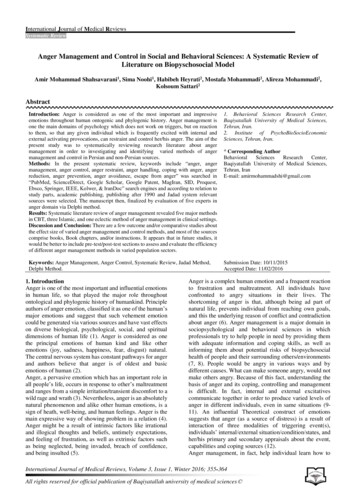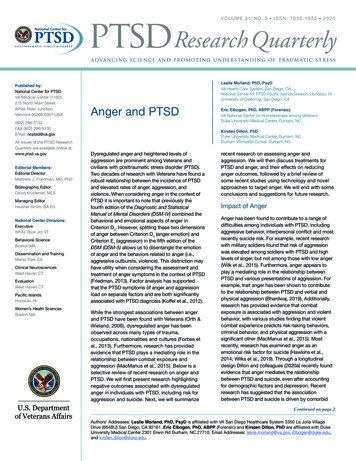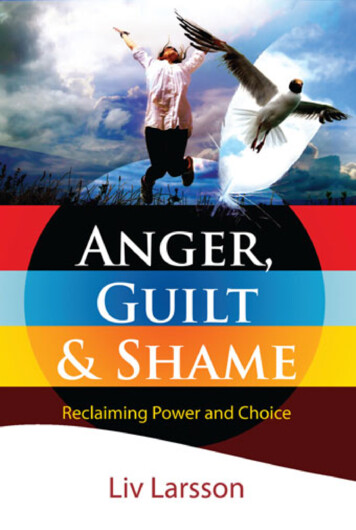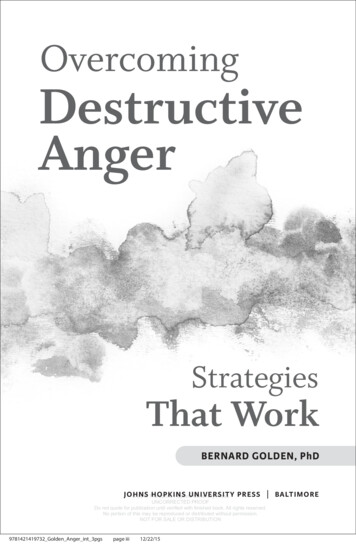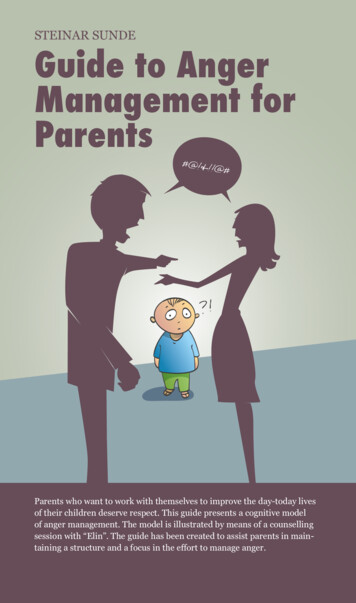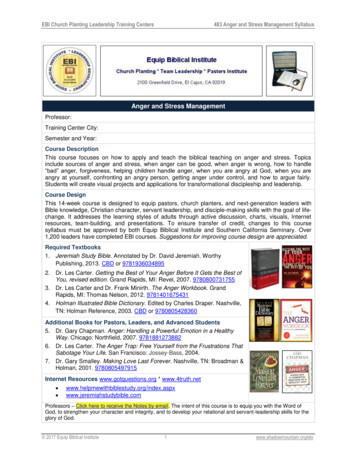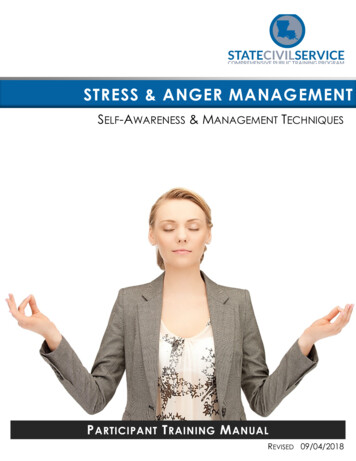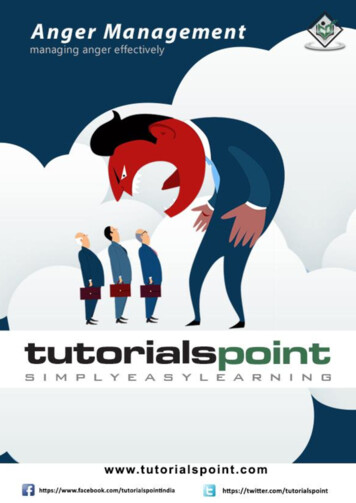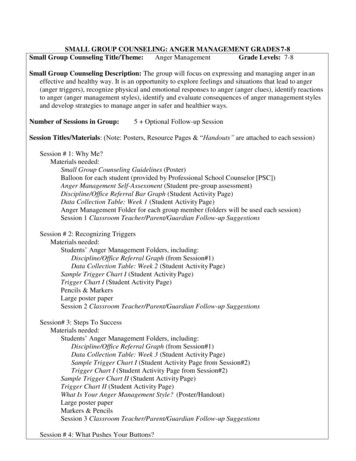
Transcription
SMALL GROUP COUNSELING: ANGER MANAGEMENT GRADES 7-8Small Group Counseling Title/Theme:Anger ManagementGrade Levels: 7-8Small Group Counseling Description: The group will focus on expressing and managing anger in aneffective and healthy way. It is an opportunity to explore feelings and situations that lead to anger(anger triggers), recognize physical and emotional responses to anger (anger clues), identify reactionsto anger (anger management styles), identify and evaluate consequences of anger management stylesand develop strategies to manage anger in safer and healthier ways.Number of Sessions in Group:5 Optional Follow-up SessionSession Titles/Materials: (Note: Posters, Resource Pages & “Handouts” are attached to each session)Session # 1: Why Me?Materials needed:Small Group Counseling Guidelines (Poster)Balloon for each student (provided by Professional School Counselor [PSC])Anger Management Self-Assessment (Student pre-group assessment)Discipline/Office Referral Bar Graph (Student Activity Page)Data Collection Table: Week 1 (Student Activity Page)Anger Management Folder for each group member (folders will be used each session)Session 1 Classroom Teacher/Parent/Guardian Follow-up SuggestionsSession # 2: Recognizing TriggersMaterials needed:Students’ Anger Management Folders, including:Discipline/Office Referral Graph (from Session#1)Data Collection Table: Week 2 (Student Activity Page)Sample Trigger Chart I (Student Activity Page)Trigger Chart I (Student Activity Page)Pencils & MarkersLarge poster paperSession 2 Classroom Teacher/Parent/Guardian Follow-up SuggestionsSession# 3: Steps To SuccessMaterials needed:Students’ Anger Management Folders, including:Discipline/Office Referral Graph (from Session#1)Data Collection Table: Week 3 (Student Activity Page)Sample Trigger Chart I (Student Activity Page from Session#2)Trigger Chart I (Student Activity Page from Session#2)Sample Trigger Chart II (Student Activity Page)Trigger Chart II (Student Activity Page)What Is Your Anger Management Style? (Poster/Handout)Large poster paperMarkers & PencilsSession 3 Classroom Teacher/Parent/Guardian Follow-up SuggestionsSession # 4: What Pushes Your Buttons?
Materials needed:Students’ Anger Management Folders, including:Discipline/Office Referral Graph (from Session#1)Data Collection Table: Week 4 (Student Activity Page)Sample Trigger Charts I & II (from Sessions #2 & 3)Trigger Chart I & II (from Sessions #2 & 3)What Is Your Anger Management Style? (from Session #3)Pencils & MarkersAnger Management Style Buttons (Pre-printed button examples—Resource Page 1)Blank red construction paper buttons (see attached button pattern—Resource Page 2)Unit Assessments (attached to the Unit Plan)Teacher Pre-Post-Group Individual Student Behavior Rating FormTeacher Feedback Form: Overall Effectiveness of GroupRequest for Feedback from Parents/Guardians (Cover Letter)Parent/Guardian Feedback Form: Overall Effectiveness of GroupSession 4 Classroom Teacher/Parent/Guardian Follow-up SuggestionsSession #5: Practice Makes Perfect.Materials neededStudents’ Anger Management Folders, including:Anger Management Self-Assessment (post-group assessment)Discipline/Office Referral Graph (from Session#1)Trigger Charts I & II (from sessions #2, 3 &4)Student Feedback Form: Overall Effectiveness of GroupSession 5 Classroom Teacher/Parent/Guardian Follow-up SuggestionsTwo (2) Student Activity Pages are listed below. They are optional activities for studentsbetween the last session and any follow-up you do. If you are not holding a follow-upsession, you may want to use them as a means to help students self-monitor their continuedprogress.I AM IN CHARGE OF ME! (Student Activity Page)Weekly Data Collection Tables (Student Activity Page)Optional Follow-up Session (4-6 weeks after Session #5)Materials needed:8 ½ x 11 piece of paper and markers for each studentAlternative Procedure: Follow-Up Feedback Form for Students.American School Counselor Association National Standard (ASCA):Personal/Social DevelopmentA. Students will acquire the knowledge, attitudes and interpersonal skills to help them understandand respect self and others.
Outcome Assessment (acceptable evidence):Summative assessment relates to the performance outcome for goals, objectives and (GLE)concepts. Assessment can be survey, whip around, etc.Students review graphs of their weekly office/discipline referrals related to anger management issuesto observe changes/fluctuations in relation to trigger situations and how their new skills helpeddiffuse ineffective/unsafe/unhealthy ways of responding to anger triggers.Utilize the Anger Management Self Assessment as pre-and post-group self-reflection tools; developan individual written plan for on-going solution-focused anger management. The plan will include:anger triggers, clues that signal anger, ways he or she will “cool down” anger, positive solutionfocused response and anticipated consequences for self and others.Perceptual Data Collection:The following end-of-group perceptual data collection forms will be used as a part of Sessions 4 & 5;the forms are attached to the Unit Plan:Classroom Teacher Assessment: The classroom teacher will complete the Teacher Pre-Post-Group Individual StudentBehavior Rating Form for each student before the group starts and after the group ends.Counselor may consider making two copies of this form, one for the pre-assessment and onefor the post-assessment, then entering all data on a final form for comparison. Teacher Feedback Form: Overall Effectiveness of Group (teacher completes at the end of thegroup).Parent/Guardian Assessment: Parent/Guardian Feedback Form: Overall Effectiveness of Group (sent home with students inSession 4; parents/guardians complete and return form with students the following week.)Student Assessment: Student Feedback Form: Overall Effectiveness of Group (students complete during Session 5)Results Based Data Collection:Follow Up Ideas & ActivitiesImplemented by counselor, administrators, teachers, parents, community partnershipsAfter each session, the PSC will provide classroom teacher(s) and parents/guardians a writtensummary of the skills learned during the session. The summary will include suggestions forclassroom and/or home reinforcement of the skills.Share data regarding office/discipline referrals with classroom teachers, parents and administratorsand enlist their support for student growth toward solution-focused anger management.
SMALL GROUP COUNSELINGTEACHER PRE-POST-GROUP PERCEPTIONSIndividual Student Behavior Rating Form(Adapted from Columbia Public Schools’ Student Behavior Rating Form)STUDENTGRADEDATE: Pre-Group AssessmentDate: Post-Group AssessmentPart 1 - Please indicate rating of pre-group areas ofconcern in the left hand column.Pre-Group ConcernsRank on a scale of 5 1(5 HIGH 1 LOW)TEACHERPart 2 - Please indicate rating of post-group areas ofconcern in the right hand column.Student Work Habits/Personal Goals ObservedPost-Group ConcernsRank on a scale of 5 1Colleagues, will you please help us evaluate thecounseling group in which this student participated. (5 HIGH 1 LOW)Your opinion is extremely important as we strive tocontinuously improve our effectiveness with ALLstudents!Academic DevelopmentFollows directionsListens attentivelyStays on taskCompliance with teacher requestsFollows rulesManages personal & school property (e.g., organized)Works neatly and carefullyParticipates in discussion and activitiesCompletes and returns homeworkPersonal and Social DevelopmentCooperates with othersShows respect for othersAllows others to work undisturbedAccepts responsibility for own mis-behavior (e.g., provokingfights, bullying, fighting, defiant, anger, stealing)Emotional Issues (e.g., perfectionism, anxiety, anger,depression, suicide, aggression, withdrawn, low selfesteem)Career DevelopmentAwareness of the World of WorkSelf-AppraisalDecision MakingGoal SettingAdd Other Concerns:
SMALL GROUP COUNSELINGTEACHER POST-GROUP PERCEPTIONS:TEACHER FEEDBACK FORM: OVERALL EFFECTIVENESS OF GROUPOne or more of your students participated in a small counseling group about. We areseeking your opinion about the effectiveness of the group e.g., students’ relationship with theprofessional school counselor and other participants in the group and your observations of students’behavioral/skill changes (positive OR negative). We appreciate your willingness to help us meet theneeds of ALL students effectively. The survey is anonymous unless you want us to contact you.Teacher’s Name (optional):Date:Professional School Counselor’s Name:Small Group Title:Before the group started, I hoped students would learn:While students were participating in the group, I noticed these changes in their behavior/attitudeUsing a scale of 5 to 1 (5 being the highest and 1 the lowest), please circle your opinion about thefollowingWhat do you think?5 High1 LowOverall, I would rate my students’ experience in the counselinggroup as:Students enjoyed working with other students in the group.5432154321Students enjoyed working with the counselor in the group.54321Students learned new skills and are using the skills in school54321I would recommend the group experience for other students.54321Additional Comments for Counselor:
SCHOOL LETTERHEADComprehensive Guidance ProgramRequest for Feedback from Parents/GuardiansSmall Group Counseling topic/title:Student’s NameTeacher’s NameDate:Dear Parent/Guardian,I have enjoyed getting to know your child in our small group counseling sessions. Next weekwill be the last session for our group. During the group sessions, we shared information relatedto a variety of topics. Below is a list of topics discussed during the group sessions.Session 1:Session 2:Session 3:Session 4:Session 5:Comments about your child’s progress:Attached is a feedback form. I would appreciate input from you about your child’s experience inthe small group. Please complete the attached Parent/Guardian Feedback Form and sendthe completed form back to school with your child by.Thank you for your support and feedback. Please contact me if you have questions orconcerns.Sincerely,Professional School Counselor
SMALL GROUP COUNSELING PARENT/GUARDIAN POST-GROUP PERCEPTIONSParent/Guardian Feedback FormYour child participated in a small counseling group about. Was this group experiencehelpful for your child? Following is a survey about changes (positive OR negative) your child made athome while participating in the group at school and since the group ended. The survey will help us meetthe needs of ALL students more effectively. The survey is anonymous unless you want the schoolcounselor to contact you. We appreciate your willingness to help usProfessional School Counselor:Date:Small Group Title:Before the group started, I hoped my child would learnI have noticed these changes in my child’s behavior and/or attitude as a result of participating in thegroup:Using a scale of 5 to 1 (5 being the highest and 1 the lowest), please circle your opinion about thefollowingWhat do you think?Overall, I would rate my child’s experience in thecounseling group as:My child enjoyed working with the other students in thegroupMy child enjoyed working with the counselor in thegroup.My child learned new skills and is using the skills in andout of schoolI would recommend the group experience to otherparents/guardians whose children might benefit fromthe small group.Additional Comments:5 High4321 Low5432154321543215432154321
SMALL GROUP COUNSELINGSTUDENT POST-GROUP PERCEPTIONS:STUDENT FEEDBACK FORM: OVERALL EFFECTIVENESS OF GROUPWe want your opinion about the effectiveness of your group. We appreciate your willingness to help usmake our work helpful to all students. The survey is anonymous unless you want us to contact you.My Name (optional):Date:Professional School Counselor’s Name:Small Group Title:Before the group started, I wanted to learnBecause of the group, I have noticed these changes in my thoughts, feelings, actions:Using a scale of 5 to 1 (5 being the highest and 1 the lowest), please circle your opinion about thefollowingWhat do you think?5 High1 LowOverall, I would rate my experience in the counseling group as:54321I enjoyed working with other students in the group54321I enjoyed working with the counselor in the group.54321I learned new skills and am using the skills in school54321If other students ask me if they should participate in a similargroup, I would recommend that they “give-it-a-try”Additional Comments for the Counselor:54321
POST-SMALL GROUP FOLLOW-UP WITH STUDENTS(OPTIONAL SESSION scheduled 4-6 weeks after group ends)FOLLOW-UP SESSION FEEDBACK FORM FOR STUDENTSName:(optional) Date:Questions:1. What specific skills are you practicing now that the group is over?2. What was the most useful thing you learned from the group?3. What could you use more practice on?4. How are things different for you now?5. What Progress have you made toward the goals you set for yourself at the end of our groupmeetings?6. How are you keeping yourself accountable?7. What suggestions do you have for future groups?8. Circle your overall experience in the group on a scale from 1 51 Most positive activity in which I have participated for a long time2 Gave me a lot of direction with my needs3 I learned a lot about myself and am ready to make definite changes4 I did not get as much as I had hoped out of the group5 The group was a waste of my time9. What specific “things” contributed to the ranking you gave your experience in the group?10. What would have made it better?Additional comments you would like to share with the school counselor:
SESSION #1Small Group Counseling Title/Theme: Anger ManagementSession Title: Why Me?Session:# 1 of 5Grade Level: 7-8Estimated time: 45 minutesSmall Group Session Purpose: Students will get acquainted with group members, establish groupguidelines, and participate in an activity that simulates what can happen if we don’t learn how tohandle anger in appropriate ways.American School Counselor Association National Standard (ASCA):Personal/Social DevelopmentA. Students will acquire the knowledge, attitudes and interpersonal skills to help themunderstand and respect self and others.SESSION #1: Materials (include activity sheets and/ or supporting resources)Small Group Counseling Guidelines (Poster)Balloon for each student (provided by Professional School Counselor [PSC])Anger Management Self-Assessment (Student pre-group assessment)Discipline/Office Referral Graph (Student Activity Page)Data Collection Table (Student Activity Page)Anger Management Folder labeled for each group member (folders will be used each session)Session 1 Classroom Teacher/Parent/Guardian Follow-up SuggestionsSESSION #1 Formative AssessmentStudents self-assess, analyze and discuss with other group members the results of their pre-group “AngerManagement Self-Assessment.” They graph discipline/office referrals related to anger management thathave occurred during the current year and discuss patterns/involvement of others related to disciplinereferrals. PSC listens for students’ anger “triggers,” anger management styles and assignment of“blame” for students’ anger (Why Me? It was someone else’s fault.”)SESSION #1 PreparationEssential Questions: Have you ever thought “Why Me? It was someone else’s fault!” when you havegotten into trouble? What can happen if no one knew how to handle anger in appropriate ways?Engagement (Hook): Give each student a balloon that represents his or her angry emotions. Studentsname a feeling associated with anger (embarrassment, hatred, frustration, stress, jealousy, left-out,competitiveness, rejection, powerless, scared, etc.). After naming an emotion, the student blows into theballoon one time for each feeling word. Ask students to discuss in what ways the balloon isrepresentative of what can happen if we do not learn to deal appropriately with feelings of anger.
Professional School Counselor Procedures: Session 1Student Involvement: Session 11. After completing the “Hook,” welcome membersand give a brief description of the group; emphasizeanger as a natural emotion everyone experiences.Anger is not bad—it is natural; it is what anger“causes” us to do that can be unsafe/unhealthy.1. Students take turns reading guidelinesaloud and contributing to a discussion of whateach one “looks and sounds like.”Following the group introduction: Give each student acopy of the Small Group Counseling Guidelines(attached). Display a poster copy and discuss eachguideline with the group members. Emphasizeconfidentiality and when YOU (as the counselor)might have to break confidentiality. Add anyguidelines the students want to add. (Display theposter during each group session.)2. Ask group members to add additional rules.2. Students give suggestions for additionalrules.3. Give each student a folder labeled with his or hername. Explain that folders are for important papersrelated to the Anger Management group; ask studentsto write the name of the group on the folders and puttheir copies of the Small Group Guidelines inside.3. Students label folders and insert guidelines.4. Give each student an Anger Management Self –Assessment form. Instruct students to complete theform individually without discussion.4. Students complete the Anger ManagementSelf-Assessment form.5. Ask for a volunteer to share results of his or herAnger Management Self-Assessment. Ask students ifthey every feel like the balloons they blew up(“Hook”). Encourage all students to participate.During discussion emphasize the difference between“angry feelings” and “angry behavior”—angry feelingsdo not get us into trouble; angry behavior can.5. Students share results of assessment andcontribute ideas about their understanding ofthe differences between “angry feelings” and“angry behavior.”6. Help students identify 1-3 personal goals they wantto set due to the results of their assessment and thediscussion. Ask students to give each other feedbackabout “first draft” goals and help each other refinepersonal goals. Instruct students to write their goals innotebooks/planners and on their Anger ManagementSelf-Assessment forms (and/or ask students to writegoals [or visual representations] on their folders) sothey are readily visible during each session.6. Students develop personal goals with thehelp of their peers. They write “refined” goalson Anger Management Self-Assessment formand insert them in their folders. Write personalgoals in notebooks/planners and review themeach day.
Professional School Counselor Procedures: Session 1Student Involvement: Session 17. Pass out the Discipline/Office Referral Graph. Tellstudents they will be making a bar graph depictingchange in the number of their discipline officereferrals. Review how to average a set of numbers;apply process to the number of referrals they havereceived during the current school year. Reviewgraphing procedures; instruct students to start theirgraphs by drawing the top line of the first “bar” at thepoint of the average number of their weekly infractionsup to this point in the school year on their Graphs.7. Students will average the number ofinfractions for each week during the currentyear. They will plot the number on theirDiscipline/Office Referral Bar Graph above“Weeks prior to Session 1” (be sure the top lineof the bar is clearly indicated)Discussion: Ask 2 or 3 volunteers to talk about theirdiscipline referrals, e.g., Were referrals for same“thing?” Were other people involved in the incidentsthat led to referral? Did he or she think or ask “Whyme? It was someone else’s fault” when referral wasmade? (Caution: The purpose of students chartingdiscipline referrals is to help them becomeaccountable; however, be cautious of discouragedstudents being “proud” of getting more disciplinereferrals than other group members get. Emphasizethat they are working toward “0” discipline referrals.)Volunteers will tell “the story” of their referralsfor discipline and/or anger issues.8. Introduce students to “Weekly Data CollectionTables.” Each week they will cut off one of the tablesand keep track of their discipline referrals on the form.Discuss the importance of recording the referrals theday they occur—if none occurs, suggest they “selfacknowledge” their success with a personal symbol.8. Students cut off the Data Collection Tablefor Week 1 and decided where they will keep itso that it is readily available.9. Collect student folders/papers (to use next session).9. Students put papers/forms in folders.10. Practice/Homework: Remind students of balloonsthey blew up during “Hook” and the title of thissession “Why Me?” Ask them to keep track of what ishappening when they begin to feel like they are goingto “pop” with anger. How often do they think/ask“Why Me?” Notice: anger feelings vs. anger behavior.Remind them to use their data collection tables to keeptrack of their office/discipline referrals.10. Students tell how they will track theirresponses to anger throughout the week (e.g.,log, journal, “sticky notes” in planners) andcommit to recording their office disciplinereferrals.11. Closure: Ask students to complete the sentence:Today I learned I11. Each student completes the sentence.12. Distribute & Explain Classroom Teacher/Parent/Guardian Follow-Up Suggestions. Send a copy homewith each student and provide a copy to classroomteacher(s) of students in group.12. Students commit to giving theirparents/guardians the handout.
SESSION #1 Follow-Up ActivitiesProvide classroom teachers copies of Classroom Teacher/Parent/Guardian Follow-up Suggestions forSession 1; verify the accuracy of the student’s discipline/referral chart with school records (planner,computer system, principal, teacher, etc.). If there is a discrepancy, the counselor will meet individuallywith the student to clarify information.SESSION #1 Counselor reflection notes (completed after the session)STUDENT LEARNING: How are all students’ lives better as a result of what happened during this session?SELF EVALUATION: Howdid I do?IMPLEMENTATION PROCEDURES:How did the session work?
ALL SESSIONS: POSTERSmall Group Counseling Guidelines1. All participants observe confidentiality.a. Counselorb. Student2. One person speaks at a time.3. Everyone has an opportunity to participate andshare.4. No PUT DOWNS allowed.5. All participants treat each other with respect.6. Group members have the opportunity to developother guidelines.
SESSION 1: STUDENT ACTIVITY PAGEAnger Management Self-AssessmentSession 1 entlyMostAlwaysAll theTimeI handle my angerwell.I get in troublebecause of myanger.I know what causesme to becomeangry.When I am angry, Ikeep my feelingsinside.When I am angry, Ilose total control.When I am angry, Italk about it.When I am angry, I“take it out” onsomeone else.When I get angry,it’s usuallysomeone else’sfault.My goals for myself by the end of the group:1.2.3.
SESSIONS 1-5: STUDENT ACTIVITY PAGE reinforces students’ scientific inquiry (part of Science PerformanceEvent of the Missouri Assessment Program; see ciPEdocs.html)Weekly Discipline/Office Referral Bar GraphYOUR PROGRESS TOWARD BEING IN-CHARGE OF YOU!WORK FOR A “0” EACH WEEK!Name:Date:Change in Discipline/Office Referrals:Session 1 through Session 5 of Anger Management Group10Number of Discipline/Office Referrals9876543210AverageWeeks Priorto Session1 (currentschool yearto this date)Week 1:(BetweenSessions1 & 2)Week 2:(BetweenSessions2 & 3)Week 3:(BetweenSessions3 & 4)Week 4:(BetweenSessions4 & 5)Week/Session NumberAverage ofweeklyreferralsbetweenSession 5 &Follow-up
SESSIONS 1-5WEEKLY DATA COLLECTION TABLES(Cut Apart Weekly Tables)DATA COLLECTION TABLE FOR WEEK 1DATA COLLECTION TABLE FOR WEEK 2DAYS OF THE WEEKDAYS OF THE WEEKTWTHMF1CLASS PERIODS/BLOCKSCLASS PERIODS/BLOCKSM23456TTHF12345677TotalsTotalsDATA COLLECTION TABLE FOR WEEK 3DATA COLLECTION TABLE FOR WEEK 4DAYS OF THE WEEK123456TWTHDAYS OF THE WEEKFMCLASS PERIODS/BLOCKSMCLASS PERIODS/BLOCKSW12345677TotalsTotalsTWTHF
ANGER MANAGEMENT SMALL COUNSELING GROUPSESSION # 1: WHY ME?7-8 CLASSROOM TEACHER/PARENT FOLLOW-UP SUGGESTIONSSession Purpose: Students got acquainted with group members, established group guidelines, andparticipated in a balloon activity that simulated what can happen if we don’t learn how to handle anger inappropriate ways.Group Activity: Students completed an Anger Management Self Assessment and set goals forthemselves.Group Assignment: Throughout the week, students use their Data Collection Table for Week 1 to chartthe number of discipline/office referrals related to anger management issues. They are to keep track ofwhat is happening around them when they begin to feel like they are going to “pop” with anger, how oftendo they think/ask “Why Me” and they are to notice: anger feelings vs. anger behavior.Classroom/Home Follow-up: Help students incorporate learning by asking them to share their personalgoals for the group; ask what help they need from you in order to reach goals. In addition, acknowledgetheir use of safe and healthy ways of responding to anger. Encourage students to track their progresstoward being in-charge of self.
SESSION #2Small Group Counseling Title/Theme:Anger ManagementSession Title Recognizing TriggersSession: # 2 of 5Grade Level:7-8Estimated time: 45 minutesSmall Group Session Purpose: Students will focus on recognizing feelings and identifying angertriggers. Students will define and identify various situations (sources), triggers that caused feelingsof anger and physical/emotional clues of anger.American School Counselor Association National Standard (ASCA):Personal/Social DevelopmentA. Students will acquire the knowledge, attitudes and interpersonal skills to help themunderstand and respect self and others.SESSION #2 Materials (include activity sheets and/ or supporting resources)Students’ Anger Management Folders including: Discipline/Office Referral Graph (from Session #1) Data Collection Tables (from Session #1)Sample Trigger Chart I (Student Activity Page)Trigger Chart I (Student Activity Page)Pencils & MarkersLarge poster paperSession 2 Classroom Teacher/Parent/Guardian Follow-up SuggestionsSESSION #2 Formative AssessmentWhile utilizing the definition of a trigger, students will identify the sources of their anger, situationsthat trigger feelings of anger, physical/emotional clues, responses and the consequences of theirresponses to anger. Students demonstrate their understanding of sources, triggers, clues, responses andthe consequences of their responses by sharing personal triggers and responses with group members.SESSION #2 PreparationEssential Questions: What are some situations and circumstance that might cause anger?Engagement (Hook): (Pre-arrange with a group member to sit in “your” chair; tell him or her aboutthe “set-up” for you to demonstrate angry behavior.) Role play by entering the group room yelling andscreaming at a student saying “Get out of my chair!” pretending to be angry and upset. Ask students“What do you think ‘triggered’ my anger?” and “Why?”
SESSION 2 PROCEDURESProfessional School Counselor Procedures: Session 2Student Involvement: Session 21. Review Small Group Guidelines and GroupAssignments from Session 1 (to track times theyfelt like they were going to “pop” with anger).How often did they wonder “Why Me?” if they gotinto trouble for their response to anger? What didthey learn about “angry feelings” vs. “angrybehavior?”1. Students listen while Small Group Guidelinesare read; they have an opportunity to askquestions/make comments about guidelines. Theyreport results of being “observers of themselves”and their angry feeling vs. angry behavior.2. Give students their Anger Management foldersfrom Session 1. Ask for 2-3 volunteers to reviewwhat they learned during the last session. Askgroup members to review the personal goals theywrote on their Anger Management SelfAssessments. On scale of 1-5 (5 high), SHOWME how you did.2. Two or three volunteers will review what theylearned during the last session. Each studentreviews personal goals and indicates how he or shedid in working toward the goals.3. Review students’ Discipline/Office ReferralsData Collection Table for Week 1; students total thenumber of discipline/office referrals incurredduring the past week and plot the number on theirbar graphs. Are bars taller or shorter than they werefor the weeks prior to the group, i.e., do they havemore or fewer referrals than the average of theweeks prior to the group? Remind group membersthat the goal is “0”3. Students graph their discipline referrals sincethe last sessions; they will share their progresstoward “0” and any concerns/challenges they had;note especially patterns in the class period(s)referrals occurred4. Introduce and define the word “trigger”—something that makes us MAD (angry) and causesus to get upset. Emphasize that people mayrespond differently to the same “trigger.”4. Students participate by asking clarifyingquestions and/or comments about meaning of“triggers.”Discussion: Distribute Sample Trigger Chart I;explain how “one thing leads to another” in thetrigger sequence; ask students to recall one of their“about to pop with anger” situations (Step 1) andidentify the sources and triggers for their feelings.Examples:a. Source – Momb. Trigger – Mom yells at me in front of myfriends. (How embarrassing!)ORa. Source—Friendb. Trigger—Told MY secret to someone else.(She betrayed me!)Students review the first two columns of SampleTrigger Chart I. Students volunteer to sharesources and triggers of their anger with members ofthe group and give examples of what happened.5. Give members copies of Trigger Chart I andinstruct students to complete the first and second5. Students complete the first and second columnsof their trigger charts;
Utilize the Anger Management Self Assessment as pre-and post-group self-reflection tools; develop an individual written plan for on-going solution-focused anger management. The plan will include: anger triggers, clues that signal anger, ways he or she will "cool down" anger, positive solution-
